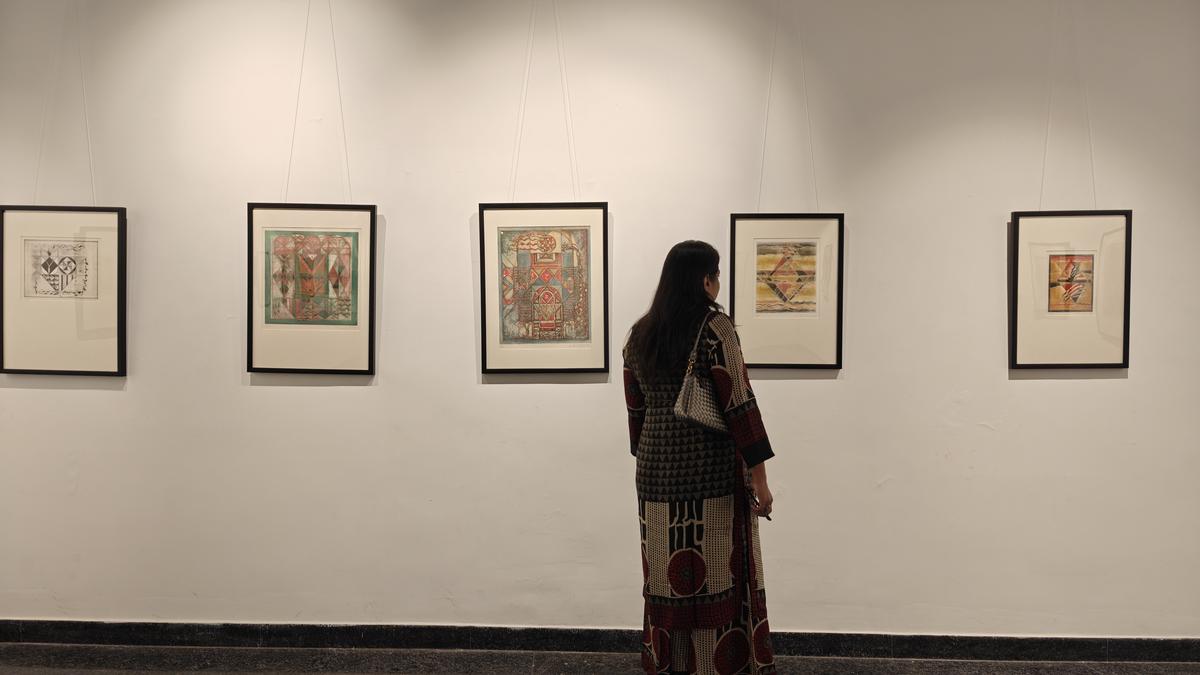
Artist Akkitham Narayanan’s world of geometric abstraction is on display in Chennai
The Hindu
Akkitham Narayanan's abstract art defies interpretation, showcased in a retrospective exhibition spanning decades in Chennai.
Akkitham Narayanan strongly believes that art cannot be translated into words, and so he shoots a friendly directive at me: “Don’t exaggerate! I have nothing to say, I am here only to show”. It is almost strange that a veteran artist, one of the pioneers of the Madras Art Movement and a darling student of KCS Paniker, would throw his hands up in the air to say that there is no specific meaning to his widely appreciated, collected and studied geometric abstractions. In fact, he is not too keen on the term itself. “Any painting can be interpreted in any way. I like the forms and so I develop the forms.”
Sporting an affable smile, the 86-year-old is at Lalit Kala Akademi today, surrounded by almost 150 works of art — sourced from collectors, friends and his own collection in the city — for a partial retrospective that charts his dalliances with the form, from the 1950s to the 2020s. Large (and small) abstracts, sometimes linear and sometimes not, with a clear preoccupation for order in chaos take over the walls for his first ever solo show in Chennai. The display, sans chronology, is a window into his revered body of work spanning decades — influences from music to printmaking and tantric art are unmissable and ‘noticeably Akkitham’.
The Kerala-born artist who obtained a diploma in Painting from the Government College of Art and Craft, Madras, in 1961, was one among the then-young promising artists who set up the Cholamandal Artists Village in seaside Madras.
“At the end of our studies in India, Panicker insisted that we look back into India, and our own traditions. He organised tours across the East, North and West, to make us understand a cross section of Indian art through temple and cave art,” he remembers. Out of this time came many of his figurative works — figuration, not in human form — dating back to the beginning of his practice in the 1950s. Paul Cezanne, William Kandinsky and Rembrandt, have all played their roles in Narayanan’s life through various stages of his career. He remembers pouring over these paintings in books back at the Connemara library.
Narayanan went to Paris on a Government scholarship where he studied painting under Jean Bertholle, and engraving under Lucien Couteau at the École des Beaux-Arts, from the end of 1967 to 1970. Moving to Paris, where he still lives, was a turning point in his life and artistic practice. For a young Narayanan, who until then had only a theoretical knowledge of European art, the exposure and interactions in the city helped realise how enmeshed art is to life. After a year largely carried by the dilemma of where and how to start, his practice began.
“When I went to Paris, I completely changed. I went to linear and geometric abstraction,” he recalls. It all began with two forms — the fundamental symbolic forms of the triangle and the square, which he later split from, and is to this day, experiments with.
Panicker used to send him letters carrying curious enquiries and sometimes prescient advice. Narayanan remembers, “He would write asking, ‘What are you doing there? You are in Europe and you must be knowing what’s happening in India too. Compare these, and do something on your own!’ That inspired me to think of doing something different.” Though his canvases are reminiscent of a kind of rhythmic chanting that can be alluded to tantric art, he strips them off any religious meaning. “I think I have done everything that I could with that.”

When reporters brought to her notice the claim by villagers that the late maharaja of Mysore Sri Jayachamaraja Wadiyar had gifted the land to them, Pramoda Devi Wadiyar said she is not aware of the matter, but sought to assure people that no effort will be made to take back the land that had been gifted by the late maharaja.





















 Run 3 Space | Play Space Running Game
Run 3 Space | Play Space Running Game Traffic Jam 3D | Online Racing Game
Traffic Jam 3D | Online Racing Game Duck Hunt | Play Old Classic Game
Duck Hunt | Play Old Classic Game










